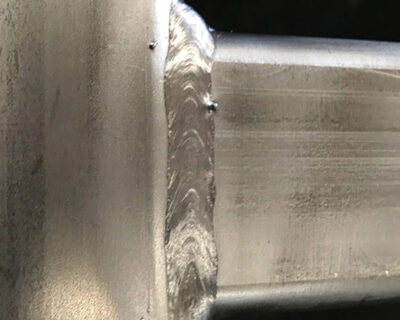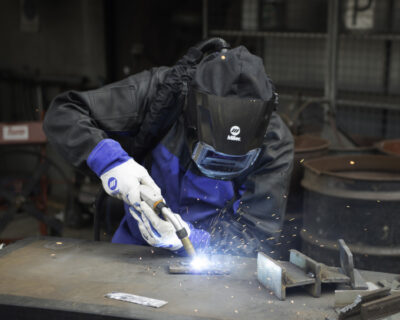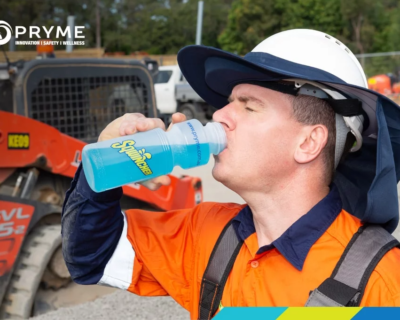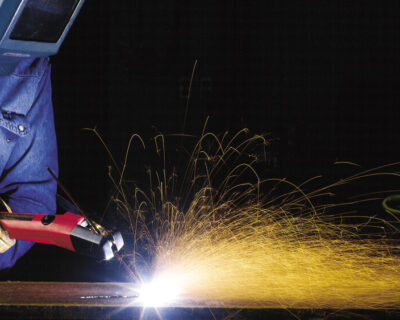Blog

Air Carbon Arc Gouging Tips for Effective Metal Removal
How to Effectively Remove Metal With Air Carbon Arc Gouging
Simple, fast, and easy, air carbon arc gouging can efficiently gouge almost all metals, making the process suitable for various industrial applications. Understanding and practicing the proper application can help you achieve better gouging results.
Air carbon arc gouging is the process of removing metal from the workpiece using the heat of a carbon arc, compressed air, and power source. The process is easy to learn and all it requires is practice. Here are some tips for getting the best out of your air carbon arc gouging technique.
Choosing the Right Electrode
Copper-coated carbon electrodes or graphite electrodes are used in the process to generate an arc. The copper coating helps minimize electrode erosion. Using the right electrode is crucial in air carbon arc gouging. There are three types of electrodes – DC plain electrodes, AC-coated electrodes, and DC copper-coated electrodes.
AC coated electrodes are used with AC power sources. DC copper-coated electrodes find wide application due to their long life, stable arc characteristics, and groove uniformity. Copper-coated carbon electrodes come in three shapes – round, half-round, and flat (rectangular). Half-round electrodes are versatile suitable for creating a flat or round gauge. Rectangular electrodes are suitable for making rectangular grooves and remove any weld reinforcements.
Electrode diameter also plays a crucial role in getting the right groove and reducing wastage. Select the correct diameter based on the depth and width of the gouge to be done. Using the correct electrode diameter helps to precisely control cutting or gouging and reduce material wastage.
If the groove depth is greater than 1.5 times the electrode diameter, it will require multiple passes to make the groove. The diameter of the selected electrode needs to be 1/8 inches wider than the depth of the groove to be done. A small electrode can be used to make a wider groove by oscillating the electrode during the process.
Choosing a Gouging Torch
The torch contains a swivel head with air holes to hold the electrode. Torches are usually air-cooled. Water-cooled cables are used for heavy-duty torches intended for high-current applications. The electrode can be fixed to the swivel head of the torch in various positions – vertical, horizontal, flat, and overhead. Turn on the air jet before striking the electrode tip on the surface of the workpiece to generate an arc.
To initiate the gouging process, the electrode is brought in contact with the metal surface and creates an arc. The air jet clears the molten metal during the process. Note that the electrode should not be withdrawn after the ignition of the electric arc. You can control the electrode movement to achieve the required smoothness of the cut.
Traditional manual torches require grip pressure of about 27 lbs. or more to open. Arcair’s AirPro X4000 has been designed to automatically open the torch jaws for ease of operation. The compressed air flowing through the torch helps to pneumatically open the torch jaws without the need for any manual pressure. This eases the operation process.
Positioning the Electrode
For copper-coated electrodes, you need to position the electrode in the torch, so the uncoated end is towards the workpiece. The air pressure should be set between 80 and 100 psi for a sufficient flow that prevents any trapping of carbon in the gouge. In normal conditions, position the electrode or carbon rod in the torch so no more than 7 inches of carbon sticks out of the torch head. With aluminum, the extension should not be more than 3 inches.
Striking an Arc
Strike the arc by slightly touching the electrode to the workpiece. When the arc strikes, the electrode should not be withdrawn. This establishes the arc. Air carbon arc gouging operates between 35 and 55 volts. The arc produced needs to be loud. A muffled arc indicates low voltage that could lead to carbon deposits.
Angle of Travel
You need to hold the torch at an angle so the electrode slopes back from the travel direction and allows the air jet to blow past the tip of the electrode. This enables the clearing of the molten metal. The torch-to-workpiece angle needs to be between 35 and 45 degrees.
Depth of the Gouge
The depth of the gouge is determined by the travel speed. A faster travel speed produces shallow gouges, and a slow travel speed gives a deeper gouge. Maintain a short arc by moving in the direction of the cut fast enough for metal removal and keep up with the electrode consumption. A steady progression of the electrode results in a smooth cut.
The Push Technique
Continuously move the electrode forward and blow the air from behind. Make sure not to back up or reverse your movement. This can help prevent carbon deposits from forming in the base material.
Focusing on the Line
If you are back gouging a weld joint, focus on the joint line visible in front of the electrode. This makes it easier to follow the weld seam. For best results and to control your gouging, hold your head behind the arc.
These air carbon arc gouging tips can help you effectively remove metal. The process requires practice and following the right techniques to make air carbon arc gouging simple and efficient for removing metals in various metal fabrication processes.




